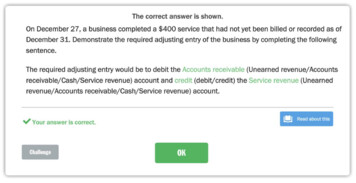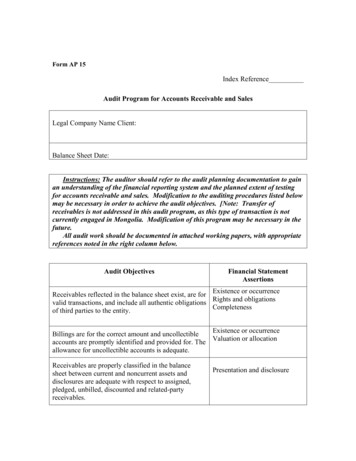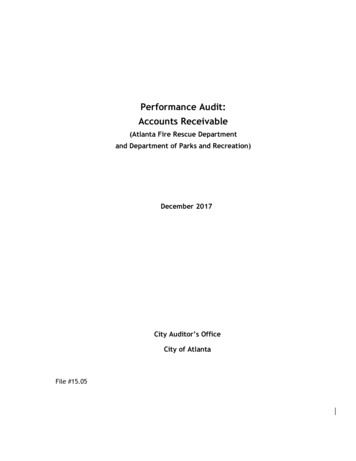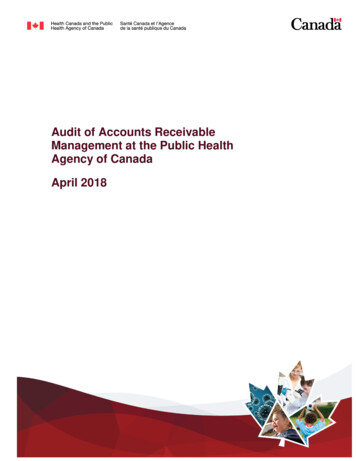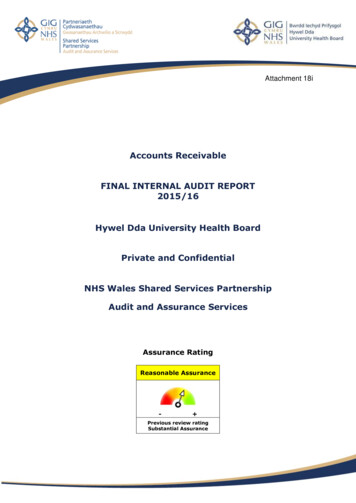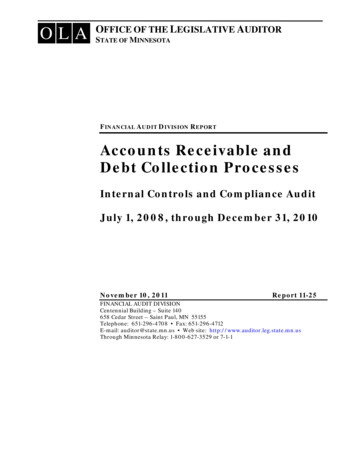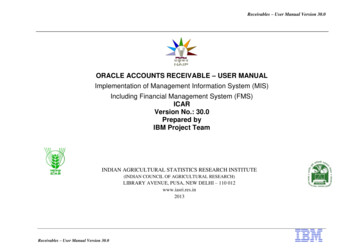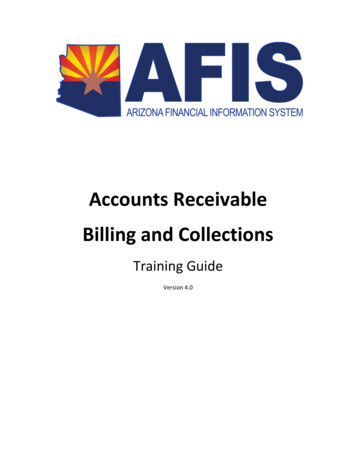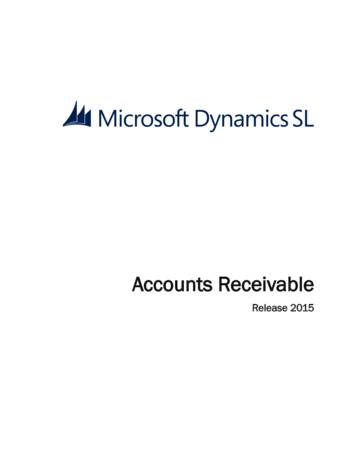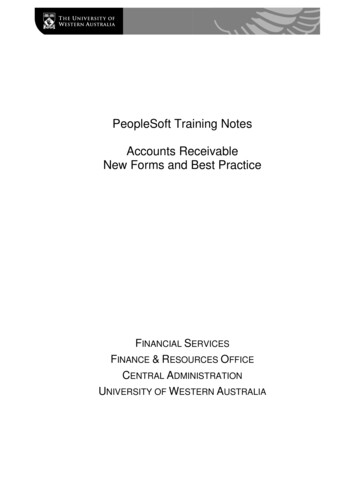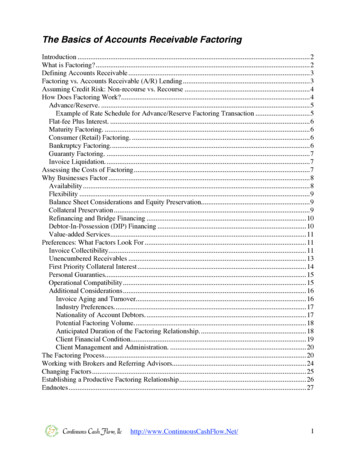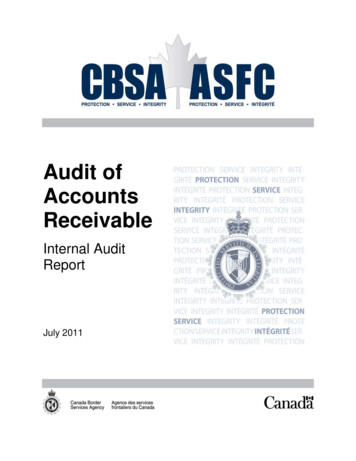
Transcription
Audit ofAccountsReceivableInternal AuditReportJuly 2011
Table of ContentsExecutive Summary. . .31.0Introduction. 51.1Background . 51.2Risk Assessment . 61.3Audit Objectives and Scope. 71.4Approach and Methodology . 81.5Audit Criteria . 81.6Statement of Assurance. 92.0Audit Opinion. 93.0Findings, Recommendations and Action Plans. 93.1Temporary Accounts Receivable System (TARS) . 93.2Preparation and Processing of Cash Receipts and Invoices. 103.3Stewardship. 12Appendix A: Audit Criteria . 17Appendix B: TARS Process Weaknesses and ARL Solutions. . .18Appendix C: List of Acronyms . 212
EXECUTIVE SUMMARYBACKGROUNDIn 2009–2010, the Canada Border Services Agency (CBSA) collected more than 21 billion in taxrevenues, with taxes receivable (i.e. accounts receivable) totalling more than 1 billion at March 31,2010. The Comptrollership Branch carries out many of the activities related to accounts receivable.However, the ports of entry are responsible for other key accounts receivable activities, such aspreparing invoices and cash receipt documents, and transferring this information to Canada RevenueAgency (CRA) Collections, where it is recorded in the accounting system as accounts receivable.A Memorandum of Understanding (MOU) exists between the CBSA and CRA that requires CRA torecord accounts receivable information in the Temporary Accounts Receivable System (TARS), pursuecollections from Canadian importers, and recommend debt write-offs to the CBSA Debt Write-OffCommittee.The Agency’s existing accounts receivable ledger system is the Temporary Accounts Receivable System(TARS), which comprises five, stand-alone, unrelated units located across Canada. It is not integrated,and it is predominantly manual. The non-integrated nature of TARS, and the fact that it is predominatelymanual, gives rise to notable control framework concerns. A new, automated accounts receivablesystem, the Accounts Receivable Ledger (ARL), is currently under development and is scheduled toreplace TARS in April 2013. The goal of the ARL project is to strengthen the CBSA’s financial controlsand reporting framework for accounts receivable, as well as improve the service the CBSA provides toCanadian businesses.The audit committee approved an audit of accounts receivable as part of the Three-Year Risk-BasedAudit Plan for 2009–2010 to 2011–2012.SIGNIFICANCE OF THIS AUDITThe Agency collects billions of dollars in tax revenues each year. In 2009–2010, approximately 320 million in duties and taxes were sent to the Agency’s service provider, CRA, for processing. Thecurrent processes and systems in place are manually intensive and non-integrative and as a result,present significant control framework concerns for the CBSA. The Agency has recognized the need tostrengthen financial controls and the reporting framework in place, as they relate to accounts receivable,and is currently developing the ARL to address these concerns. Accordingly, this audit is of importanceas it provides assurance on the extent to which the new ARL project will address current weaknesses inthe accounts receivable process. It also identifies risks in the interim period to which the CBSA remainsexposed.AUDIT OBJECTIVES AND SCOPEThe audit included two objectives:3
1. To assess the current accounts receivable processes and controls in place at the Agency,including:a. the preparation and processing of cash receipts and invoices;b. the controls relating to the security of TARS data;c. the procedures for monitoring accounts receivable balances and for writing off bad debts;andd. the processes for calculating interest on overdue accounts.2. To assess the extent to which the new ARL system will address significant deficiencies that mayexist in the current accounts receivable system.The audit did not include a review of the assessment process, which determines the amount of duties andtaxes owed to the Agency. The Office of the Auditor General (OAG) examined this process as part of itsfall 2010 Report to the Auditor General of Canada.AUDIT OPINIONWith respect to current accounts receivable processes and controls, the audit found a number of issues ofa non-financial nature in the preparation and processing of cash receipts and invoices which areconsidered low risk but create inefficiencies and negatively impact service provided to Canadianbusinesses. The audit found controls related to the security of TARS data and procedures for writing offbad debts to be adequate and makes recommendations related to accounts receivable monitoringactivities and the calculation of interest on overdue accounts.In addition, the audit concludes that the deficiencies noted in the accounts receivable process should beaddressed by the new ARL system.KEY FINDINGSSome weaknesses occurred at the port of entry level. The most significant related to inaccuracies of anon-financial nature in preparing invoices and cash receipt documents by the ports of entry. We alsonoted deficiencies related to the completeness and timeliness of accounts receivable information that theports of entry sent to the CRA office. These deficiencies resulted in increased workloads for CRA staffin following up and correcting them and resulted in delays in collecting monies owed. While the auditdid not find that these errors had resulted in a loss of revenue, they do negatively affect the servicewhich the Agency provides to Canadian importers.Audit testing concluded that there were adequate safeguards to protect against unauthorized access toTARS.We found that the Agency appropriately reviews the list of debt write-offs that are recommended by theCRA. Regarding monitoring of accounts receivable, the Agency has recently implemented some4
monitoring procedures; however, more rigor is required. The new ARL project should also providecomprehensive information to management to permit more active monitoring of AR.The roles and responsibilities of the various parties involved in calculating and collecting interest, andthe policy and procedures for determining when interest begins to accrue on overdue accounts wereunclear. As a result, policies and procedures are applied inconsistently at the ports of entry offices. Thisrepresents a risk that the Agency could either under-charge or over-charge interest to importers. It alsohas negative implications for the service the Agency provides to Canadian importers.When the new ARL system becomes operational in 2013, it is expected to address the weaknesses inTARS that the audit identified, including those listed above.RECOMMENDATIONSThe audit has made recommendations on:1. improving the accuracy and timeliness of cash receipt and invoice documents sent to CRA;2. enhancing the rigor of the accounts receivable monitoring process; and3. clarifying and implementing the policy related to the calculation of interest on overdue accountsto ensure it is appropriately developed within the ARL.STATEMENT OF ASSURANCEThe audit engagement was planned and conducted in accordance with the Internal Auditing Standardsfor the Government of Canada.MANAGEMENT RESPONSEThe observations, comments and recommendations contained in the audit report are reasonable and fair.Prior to the implementation of the ARL, the proposed Management Action Plan will focus on interimsolutions that will address issues and risks identified in the audit report. Furthermore, active monitoringof the ARL Project will ensure that gaps and weaknesses are addressed. The recommendations and theproposed Management Action Plans are detailed within the audit report.1.0INTRODUCTION1.1BACKGROUNDThe Canada Border Services Agency (CBSA) became an independent entity in December 2003. TheAgency’s mandate includes, but is not limited to, assessing and collecting duties and taxes on goodsimported into Canada. In 2009–2010, the Agency collected more than 21 billion in tax revenues, withtaxes receivable (i.e. accounts receivable) totalling over 1 billion at March 31, 2010.5
The CBSA’s current Temporary Accounts Receivable System (TARS) is not integrated — i.e. thesystem has five stand-alone units located across Canada — and it is predominantly manual. Forexample, significant components of the CBSA’s invoicing, cash collections, and various ledgerreconciliation processes are manually performed.The non-integrated nature of TARS, and the fact that it involves many manual processes, representsnotable control framework concerns. A new, automated accounts receivable system, the AccountsReceivable Ledger (ARL), is currently under development and is scheduled to replace TARS in April2013. The ARL project is expected to address existing accounts receivable (AR) and revenue-processingdifficulties and improve internal controls by integrating and standardizing program functions (i.e. allreceipt and invoice forms will be automated), maintaining information by client accounts, andcontrolling accounts receivable information. The goal of the ARL project is to provide the CBSA with afully integrated client-based accounting system.When it becomes operational, the ARL will improve service to Canadian importers by, for example,introducing electronic payment remittances and providing a more efficient and accurate process formaintaining and managing current accounts receivable by client. At the same time, it will strengthen theCBSA’s financial controls and reporting framework.Although the CBSA is the owner of the Temporary Accounts Receivable System legacy system, CanadaRevenue Agency (CRA) operates it. An MOU between the CBSA and Canada Revenue Agency (CRA)requires CRA to record accounts receivable information in TARS, pursue collections from Canadianimporters, and recommend debt write-offs to the CBSA Debt Write-Off Committee.The CBSA is responsible for preparing invoices and cash receipt documents at the Port offices, and forsending these invoices and cash receipt forms to CRA Collections to be recorded in TARS. However, itis the CBSA Revenue Accounting and Reporting Division (RARD) that is responsible for substantiatingthe accounts-receivable balance and for determining the appropriate accrual entries. Due to the nonintegrative nature of the five TARS units, the system does not gather and integrate data from theseparate units and therefore a great deal of manual processing is needed by RARD.The audit committee approved an audit of accounts receivable as part of the Three-Year Risk-BasedAudit Plan for 2009–2010 to 2011–2012.1.2RISK ASSESSMENTThe following key risks were identified during the planning phase of the audit:Preparation and Processing of Cash Receipts and Invoices The preparation of cash receipts and invoice documentation at the ports of entry is predominatelymanual, which creates a risk that errors could be made. The preparation of these documents is also akey early stage in the AR process. Additionally, all documents prepared may not be transmitted in atimely manner from the ports of entry to CRA, or at all. These weaknesses pose the risk of lostrevenue, poor customer service being provided to Canadian importers and inefficiencies in thecollections processes.6
Stewardship If effective controls for safeguarding access to TARS and protecting TARS data are not in place,then records and data in TARS could be compromised or lost. There is a risk that the absence of effective controls and procedures relating to the management ofaccounts receivable and the write-off of bad debts could result in lost revenue (i.e. accountsreceivable written off that could still be collected) or misstatements in financial reporting (i.e.overstatement of the value of accounts receivable). If appropriate controls and procedures are not in place for calculating and collecting interest onoverdue accounts, there is a risk of lost revenue and the perception of poor customer service.Temporary Accounts Receivable System (TARS) The most significant risk is that management may not have identified all critical issues and importantdeficiencies in the existing accounts receivable system, and as a result, the new ARL system may notaddress them and therefore may not produce the expected benefits.The new ARL system, currently under development, is expected to address the risks identified abovewhich were noted during the planning phase of this audit. However, the Agency remains exposed tothese risks in the interim period.1.3AUDIT OBJECTIVES AND SCOPEThe audit included two objectives:1. To assess the current accounts receivable processes and controls in place at the Agency,including:a. the preparation and processing of cash receipts and invoices;b. the controls relating to the security of TARS data;c. the procedures for monitoring accounts receivable balances and for writing off bad debts;andd. the pro
system, the Accounts Receivable Ledger (ARL), is currently under development and is scheduled to replace TARS in April 2013. The goal of the ARL project is to strengthen the CBSA’s financial controls and reporting framework for accounts receivable, as well as improve the service the CBSA provides to Canadian businesses.
